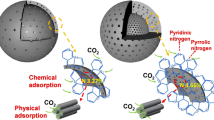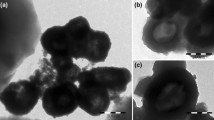Abstract
Nitrogen-doped hierarchical porous hollow carbon microspheres (N-HPHCS) are synthesized using melamine-formaldehyde (MF) resin as carbon and nitrogen sources, sulfonated polystyrene microspheres (SPS) as the core template, and SiO2 nanoparticles as the mesopore forming agent. The obtained microspheres are composed of SPS core and MF/SiO2 composite shell (SPS@MF/SiO2). This SPS@MF/SiO2 is then calcined and acid-treated to obtain N-HPHCS. During the calcination, SPS core is removed, and the micropores are formed on the shell owing to the thermal decomposition of the MF resin. After chemical etching of the SiO2 nanoparticles, mesopores are generated on the carbon shell. The as-prepared sample of N-HPHCS has high surface area and large pore volume, and exhibits catalytic activity toward oxygen reduction reaction (ORR). The electrocatalytic performance of N-HPHCS can be ascribed not only to the doped nitrogen atoms, but also to the hierarchical porous structure.





Similar content being viewed by others
REFERENCES
Khan, M.A., Zhao, H., Zou, W., Chen, Z., Cao, W., Fang, J., Xu, J., Zhang, L., and Zhang, J., Recent progresses in electrocatalysts for water electrolysis, Electrochem. Energy Rev., 2018, vol. 1, p. 483.
Wang, X., Feng, J., and Bai, Y., Synthesis, properties, and applications of hollow micro-/nanostructures, Chem. Rev., 2016, vol. 116, p. 10983.
Li, S., Pasc, A., Fierro, V., and Celzard, A., Hollow carbon spheres, synthesis and applications—a review, J. Mater. Chem. A, 2016, vol. 4, p. 12686.
Ng, S., Yilmaz, G., and Ong, W.L., One-step aqctivation towards spontaneous etching of hollow and hierarchical porous carbon nanospheres for enhanced pollutant adsorption and energy storage, Appl. Catal. B Environ., 2018, vol. 220, p. 533.
Roberts, A.D., Li, X., and Zhang, H., Porous carbon spheres and monoliths: morphology control, pore size tuning and their applications as Li-ion battery anode materials, Chem. Soc. Rev., 2014, vol. 43, p. 4341.
Gong, Y., Wei, Z., and Wang, J.P., Design and fabrication of hierarchically porous carbon with a template-free method, Sci. Rep., 2014, vol. 4, p. 6349.
Du, G., Bian, Q., and Zhang, J., Rsc. Adv., 2017, vol. 7, p. 46329.
Cychosz, K.A., Guillet-Nicolas, R., and Garcia-Martinez, J., Recent advances in the textural characterization of hierarchically structured nanoporous materials, J. Chem. Soc. Rev., 2017, vol. 46, p. 389.
Liu, J., Wickramaratne, N.P., Qiao, S.Z., and Jarniecz, M., Molecular-based design and emerging applications of nanoporous carbon spheres, Nat. Mater., 2015, vol. 14, p. 763.
Zhang, W., Cui, T., and Yang, L., Hollow-structured conjugated porous polymer derived iron/nitrogen-codoped hierarchical porous carbons as highly efficient electrocatalyst, J. Colloid Interface Sci., 2017, vol. 497, p. 108.
Wenelska, K., Ottmann, A., Moszyński, D., Klingeler, R., and Mijowska, E., Facile synthesis N-doped hollow carbon spheres from spherical solid silica, J. Colloid Interface Sci., 2018, vol. 511, p. 203.
Wang, H., Maiyalagan, T., and Wang, X., Review on recent progress in nitrogen-doped grapheme: synthesis, characterization and its potential applications, ACS Catal., 2012, vol. 2, p. 781.
Geng, D., Ding, N., and Hor, T.S.A., Potential of metal-free “grapheme-allow” as electrocatalysts for oxygen reduction reaction, J. Mater. Chem. A, 2015, vol. 3, p. 1795.
Zhou, W., Xiao, X., and Cai, M., Polydopamine-coated, nitrogen-doped, hollow carbon-sulfur double-layered core-shell structure for improving lithium-sulfur batteries, Nano. Lett., 2014, vol. 14, p. 5250.
Chen, X.Y., Chen, C., Zhang, J.C., and Xie, D.H., Nitrogen-doped porous carbon spheres derived from polyacrylamide, Ind. Eng. Chem. Res., 2013, vol. 52, p. 12025.
Han, J., Xu, G., and Ding, J., Porous nitrogen-doped hollow carbon spheres derived from polyaniline for high performance supercpacitors, Mater. Chem. A, 2014, vol. 2, p. 5352.
Wang, L., Gao, Z., and Chang, J., Nitrogen-doped porous carbons as electrode materials for high-performance supercapacitor and dye-sensitized solar cells, ACS Appl. Mater. Interfaces, 2015, vol. 7, p. 20234.
Friedel, B. and Greulich-Weber, S., Preparation o monodisperse, submicrometer carbon spheres by pyrolysis of melamine-formaldehyde resin, Small, 2006, vol. 2, p. 859.
Mou, S., Lu, Y., and Jiang, Y., A facile and cheap coating method to prepare SiO2/melamine-formaldehyde and SiO2/urea-formaldehyde composite microspheres, Appl. Surf. Sci., 2016, vol. 384, p. 258.
Li, W., Chen, D., and Li, Z., Nitrogen-containing carbon spheres with very large uniform mesopores: the superior electrode materials for EDLC in organic electrolyte, Carbon, 2007, vol. 9, p. 1757.
Zhang, J., Wang, M., and Ge, X., Facile fabrication of free-standing colloidal-crystal films by interfacial self-assembly, J. Colloid Interface Sci., 2011, vol. 353, p. 16.
Wu, Y., Li, Y., and Qin, L., Monodispersed or narrow-dispersed melamine-formaldehyde resin polymer colloidal spheres: preparation, size-control, modification, bioconjugation and particle formation mechanism, J. Mater. Chem. B, 2013, vol. 1, p. 204.
Hay, J.N., Application of the modified Avrami equations to polymer crystallization kinetics, Br. Polym. J., 1971, vol. 3, p. 74.
Yamamoto, K., Koga, Y., and Fujiwara, S., Binding energies of amorphous CN and SiCN films on X-ray photoelectron spectroscopy, Jpn. J. Appl. Phys., 2001, vol. 40, p. 123.
You, S., Ma, M., and Wang, W., 3D macroporous nitrogen-enriched graphitic-carbon scaffold for efficient bioelectricity generation in microbial fuel cells, Adv. Energy Mater., 2017, vol. 7, p. 1601364.
Sun, G., Ma, L., and Ran, J., template synthesis and activation of highly nitrogen-doped worm-like carbon composites based on melamine-urea-formaldehyde resins for high performance supercapacitors, Electrochim. Acta, 2016, vol. 194, p. 168.
Yan, W., Wang, L., and Chen, C., Polystyrene microspheres-templated nitrogen-doped grapheme hollow spheres as metal-free catalyst for oxygen reduction reaction, Electrochim. Acta, 2016, vol. 188, p. 230.
Guo, D., Shibuya, R., and Akiba, C., Active sites of nitrogen-doped carbon materials for oxygen reduction reaction clarified using model catalysts, Science, 2016, vol. 22, p. 361.
Ma, F., Zhao, H., and Sun, L., A facile route for nitrogen-doped hollow graphitic carbon spheres with superior performance in supercapacitors, J. Mater. Chem., 2012, vol. 22, p. 13464.
Li, M., Zhang, Y., and Yang, L., Hollow melamine resin-based carbon spheres/grapheme composite with excellent performance for supercapacitors, Electrochim. Acta, 2015, vol. 166, p. 310.
Tan, Y.T., Ran, F. and Wang, L.R., Synthesis and electrochemical properties of hollow polyaniline microspheres by a sulfonated polystyrene template, J. Appl. Polym. Sci., 2013, vol. 127, p. 1544.
Sun, D., Zhang, R., and Liu, Z., Polypropylene/silica nanocomposites prepared by in-situ sol–gel reaction with the aid of CO2, Macromolecules, 2005, vol. 38, p. 5617.
Liu, C., Ge, C., and Wang, A., Synthesis of porous hollow silica spheres using functionalized polystyrene latex spheres as templates, Korean J., Chem. Eng., 2011, vol. 28, p. 1458.
Qian, Y., Hu, Z., and Ge, X., A metal-free ORR/OER bifunctional electrocatalyst derived from metal-organic frameworks for rechargeable Zn-air batteries, Carbon, 2017, vol. 111, p. 641.
Lin, Z., Waller, G.H., and Liu, Y., Simple preparation of nanoporous few-layer nitrogen-doped grapheme for use as an efficient electrocatalyst for oxygen reduction and oxygen evolution reactions, Carbon, 2013, vol. 53, p. 130.
Jiang, D.D., Yao, Q., and McKinney, M.A., TGA/FTIR studies on the thermal degradation of some polymerical sulfonic and phosphonic acids and their sodium salts, Polym. Degr. Stab., 1999, vol. 63, p. 423.
Zhou, Y., Yu, J., and Wang, X., Preparation of KH570-SiO2 and their modification on the MF/PVA composite membrane, Fiber. Polym., 2015, vol. 16, p. 1772.
Wang, Y.-J., Fang, B., Zhang, D., Li, A., Wilkinson, D.P., Ignaszak, A., Zhang, L., and Zhang, J., A review of carbon-composited materials as air-electrode bi-functional electrocatalysts for metal-air batteries, Electrochem. Energy Rev., 2018, vol. 1, p. 1.
ACKNOWLEDGMENTS
The authors acknowledge the support of the National Natural Science Foundation of China (nos. 51602189, 51803116); Aeronautical Science Foundation of China (2016ZFS6001, 2017ZFS6001); Zhaoqing Xijiang Talent Program.
Author information
Authors and Affiliations
Corresponding authors
Ethics declarations
The authors declare that they have no conflict of interest.
Additional information
This paper is dedicated to the 80th anniversary of Professor V.V. Malev who has made a considerable contribution into modern directions of electrochemistry.
Rights and permissions
About this article
Cite this article
Li Dong, Chen, X., Ma, J. et al. Nitrogen-Doped Hierarchical Porous Hollow Carbon Microspheres for Electrochemical Energy Conversion. Russ J Electrochem 55, 1098–1109 (2019). https://doi.org/10.1134/S1023193519110053
Received:
Revised:
Accepted:
Published:
Issue Date:
DOI: https://doi.org/10.1134/S1023193519110053




